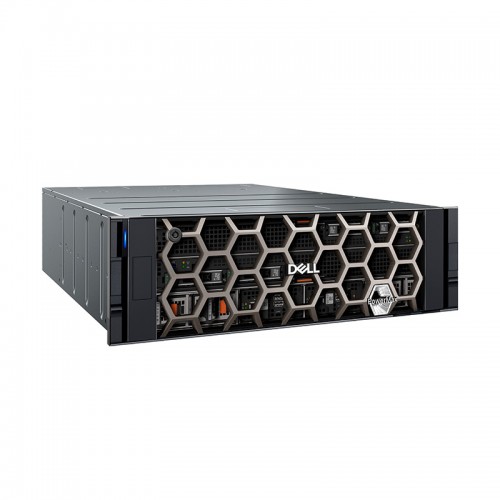- Shop
- Storage solutions
- Dell EMC PowerMax 2500
-
Overview
The Dell EMC PowerMax 2500 is a mission-critical, all-flash, end-to-end NVMe storage array designed for enterprises that demand high performance, resilience, and flexibility. It supports mixed workload environments—including block, file, and mainframe—and features Dell’s PowerMaxOS platform with advanced data services, intelligent automation, and cyber-resiliency.
The system offers a modular scale-up and scale-out architecture, enabling small initial footprints with expansion as demand grows (up to two node pairs). It also delivers guaranteed data reduction, integrated encryption, and seamless upgrades to protect data integrity and operational continuity.
Key Features
- All-flash, end-to-end NVMe architecture for ultra-low latency and high throughput
- Scalable architecture (1 or 2 node pairs) with Dynamic Media Enclosures (DMEs) to scale capacity
- Support for multiple protocols: FC, NVMe/FC, NVMe/TCP, iSCSI, block, file, mainframe, vVols, containers
- Global inline data reduction (deduplication, compression) with guaranteed ratios (5:1 for open systems, 3:1 for mainframe)
- Native data protection: snapshots, thin clones, immutable snapshots, point-in-time consistency
- Native remote replication: synchronous, asynchronous, vVol replication, and SRDF/Metro Smart DR support
- Integrated encryption (SED) with optional external key management (KMIP)
- Cyber resiliency features: hardware root of trust, secure boot, immutable snapshots, anomaly detection, vaulting
- Non-disruptive operations: software upgrades (PowerMaxOS), scale expansions, and maintenance without downtime
- Unified management via GUI (Unisphere), CLI, REST APIs; support for AIOps, telemetry, and power/thermal monitoring
- Intelligent power and cooling with real-time monitoring and alerting
Specifications
Category
Details
Architecture & Scaling
1 to 2 node pairs per array; modular DMEs for capacity expansion
Processor
Intel Xeon Gold 5218 at 2.8 GHz, 16 cores per CPU; 64 cores per node pair
Cache / Memory
Base: 896 GB raw; maximum (via scale) up to 15.36 TB raw
Drive Types / Media
NVMe SSDs (2.5") — 3.84 TB, 7.68 TB, 15.36 TB, 30.72 TB (TLC/QLC)
Max Drives
Up to 96 drives per array
Effective Capacity
Up to ~8 PebiBytes (or 8.8 PBe) in open systems
Protocols Supported
FC, NVMe/FC, NVMe/TCP, iSCSI, NFS, SMB, SRDF, vVol replication, FICON, container storage
Data Services
Inline deduplication & compression, thin provisioning, thin clones, snapshots, secure immutable snapshots
Data Protection / Replication
Local protection, remote replication (sync/async), SRDF/Metro, vVol replication
Security / Cyber Resiliency
Encryption at rest (SED), external key management, hardware root of trust, secure boot, anomaly detection, immutable snapshots, cyber vault
Management
Unisphere (GUI), CLI, REST API, telemetry, power/thermal dashboards, AIOps
Power / Consumption
Single node-pair + DME: up to ~2.213 kVA typical at 26°C; ~3.131 kVA max >35°C
Heat Dissipation
Up to ~10,683 BTU/hr at high ambient (35 °C)
AC Input / Voltages
200-240 VAC ±10%, single-phase or three-phase, 50/60 Hz
Physical Dimensions
Rack Enclosure: Height 199.2 cm, Width 60 cm, Depth 114.8 cm
Component Sizes
Node pair: 3U height, depth 79 cm; DME: 2U, depth ~70.9 cm
Weight
Single cabinet (node + DME): ~306 kg; Dual node + DME: ~408 kg
Rack / PDU Requirements
Requires dedicated PDUs and line cords per zone; supports multiple PDUs for expansion and co-located equipment
Reliability & Availability
Designed for “six nines” (99.9999%) availability


